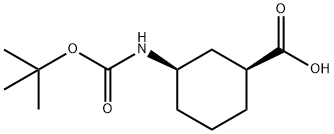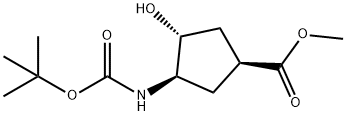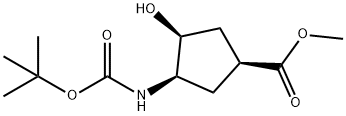(+)-(1S,3R)-N-BOC-3-AMINOCYCLOPENTANECARBOXYLIC ACID
- CAS NO.:261165-05-3
- Empirical Formula: C11H19NO4
- Molecular Weight: 229.27
- MDL number: MFCD01320857
- SAFETY DATA SHEET (SDS)
- Update Date: 2025-01-27 09:38:02

What is (+)-(1S,3R)-N-BOC-3-AMINOCYCLOPENTANECARBOXYLIC ACID?
Chemical properties
white powder or chunks
The Uses of (+)-(1S,3R)-N-BOC-3-AMINOCYCLOPENTANECARBOXYLIC ACID
(-)-(1R,3S)-N-Boc-1-Aminocyclopentane-3-carboxylic Acid is a reagent used in the synthesis of 3-substituted aminocyclopentanes as potent NR2B subtype-sellective NMDA antagonists in the treatment of neuropathic pain and Parkinson’s.
Properties of (+)-(1S,3R)-N-BOC-3-AMINOCYCLOPENTANECARBOXYLIC ACID
| Melting point: | 35-49 °C |
| Boiling point: | 371.18°C (rough estimate) |
| Density | 1.1482 (rough estimate) |
| refractive index | 1.4490 (estimate) |
| storage temp. | Keep in dark place,Sealed in dry,Room Temperature |
| solubility | slightly sol. in Methanol |
| form | Powder or Chunks |
| pka | 4.62±0.40(Predicted) |
| color | White |
| optical activity | [α]/D +16.0±1°, c = 1% in methanol |
Safety information for (+)-(1S,3R)-N-BOC-3-AMINOCYCLOPENTANECARBOXYLIC ACID
| Signal word | Warning |
| Pictogram(s) |
 Exclamation Mark Irritant GHS07 |
| GHS Hazard Statements |
H315:Skin corrosion/irritation H319:Serious eye damage/eye irritation H335:Specific target organ toxicity, single exposure;Respiratory tract irritation |
| Precautionary Statement Codes |
P261:Avoid breathing dust/fume/gas/mist/vapours/spray. P305+P351+P338:IF IN EYES: Rinse cautiously with water for several minutes. Remove contact lenses, if present and easy to do. Continuerinsing. |
Computed Descriptors for (+)-(1S,3R)-N-BOC-3-AMINOCYCLOPENTANECARBOXYLIC ACID
New Products
3-pyridine carboxaldehyde 7-bromoquinoxalin-2(1H)-one 8-Bromoisoquinoline 2-Bromo-6-flurobenzaldehyde 3-Pyridineacetonitrile, α-amino-, hydrochloride (1:1) Trans-methyl 4-aminocyclohexane- carboxylate HCl N-Boc-L-Alaninol 4-[2-(DIMETHYLAMINO)ETHOXY]BENZYLAMINE Ibanic Acid Suzetrigine 5,6-Dichloronicotinic acid 2-(2-chloroethoxy)-5-nitrobenzaldehyde Dimethyl 4-aminothiophene-2,3-dicarboxylate hydrochloride Remibrutinib 1H-Indole-1-carboxylic acid, 5-hydroxy-7-methyl-, 1,1-dimethylethyl ester N N N'Trimethyl ethylenediamine Lead II Bromide Variamine Blue B Diazonium salt N N' DimethylEthylenediamine Ethyl Methanesulfonate N Ethylmethylamine Radiator Flux Zinc Chloride Solution (All Grades) H-Ser(t-Bu)-Ser(t-Bu)-Gly-OHRelated products of tetrahydrofuran




![4-[(TERT-BUTOXYCARBONYL)AMINO]BICYCLO[2.1.1]HEXANE-1-CARBOXYLIC ACID](https://img.chemicalbook.in/CAS/20150408/GIF/1050886-56-0.gif)



You may like
-
 (1S,3R)-3-(tert-Butoxycarbonylamino)cyclopentanecarboxylic Acid CAS 261165-05-3View Details
(1S,3R)-3-(tert-Butoxycarbonylamino)cyclopentanecarboxylic Acid CAS 261165-05-3View Details
261165-05-3 -
 1181267-33-3 99%View Details
1181267-33-3 99%View Details
1181267-33-3 -
 2,4-Difluoro-alpha-(1H- 1,2,4,Triazolyl)acetophenone 99%View Details
2,4-Difluoro-alpha-(1H- 1,2,4,Triazolyl)acetophenone 99%View Details
86404-63-9 -
 1076-22-8 3-Methyl xanthine 99%View Details
1076-22-8 3-Methyl xanthine 99%View Details
1076-22-8 -
 161596-47-0 99%View Details
161596-47-0 99%View Details
161596-47-0 -
 3-Amino-4-pyrazole carboxamide hemisulfate 27511-79-1 99%View Details
3-Amino-4-pyrazole carboxamide hemisulfate 27511-79-1 99%View Details
27511-79-1 -
 3-Dimethl amino-1- (naphthalen-1-yl)propan-1- one hydro chloride 99%View Details
3-Dimethl amino-1- (naphthalen-1-yl)propan-1- one hydro chloride 99%View Details
5409-58-5 -
 109113-72-6 2-(chloro methyl)-4-methyl quinazoline 99%View Details
109113-72-6 2-(chloro methyl)-4-methyl quinazoline 99%View Details
109113-72-6
Statement: All products displayed on this website are only used for non medical purposes such as industrial applications or scientific research, and cannot be used for clinical diagnosis or treatment of humans or animals. They are not medicinal or edible.
